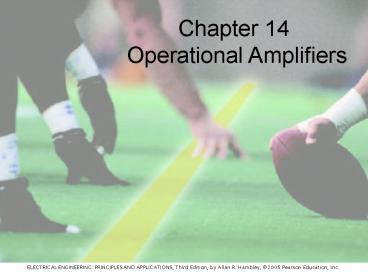Chapter 14 Operational Amplifiers - PowerPoint PPT Presentation
1 / 81
Title:
Chapter 14 Operational Amplifiers
Description:
IDEAL OPERATIONAL AMPLIFIERS The input signal of a differential amplifier consists of a differential component and a common-mode component. – PowerPoint PPT presentation
Number of Views:882
Avg rating:3.0/5.0
Title: Chapter 14 Operational Amplifiers
1
Chapter 14 Operational Amplifiers
2
Chapter 14 Operational Amplifiers
- List the characteristics of ideal op amps.
- 2. Identify negative feedback in op-amp circuits.
- 3. Analyze ideal op-amp circuits that have
negative - feedback using the summing-point constraint.
3
4. Select op-amp circuit configurations suitable
for various applications. 5. Design useful
circuits using op amps. 6. Identify practical
op-amp limitations and recognize potential
inaccuracies in instrumentation
applications. 7. Work with instrumentation
amplifiers. 8. Apply integrators,
differentiators, and active filters.
4
IDEAL OPERATIONAL AMPLIFIERS
5
The input signal of a differential amplifier
consists of a differential component and a
common-mode component.
6
Characteristics of Ideal Op Amps
- Infinite gain for the differential input signal
- Zero gain for the common-mode input signal
- Infinite input impedances
- Zero output impedance
- Infinite bandwidth
7
(No Transcript)
8
(No Transcript)
9
SUMMING-POINT CONSTRAINT
Operational amplifiers are almost always used
with negative feedback, in which part of the
output signal is returned to the input in
opposition to the source signal.
10
In a negative feedback system, the ideal
op-amp output voltage attains the value needed to
force the differential input voltage and input
current to zero. We call this fact the
summing-point constraint.
11
Ideal op-amp circuits are analyzed by the
following steps
- Verify that negative feedback is present.
- 2. Assume that the differential input voltage
and the input current of the op amp are forced
to zero. (This is the summing-point constraint.)
12
3. Apply standard circuit-analysis principles,
such as Kirchhoffs laws and Ohms law, to
solve for the quantities of interest.
13
(No Transcript)
14
(No Transcript)
15
INVERTING AMPLIFIERS
16
(No Transcript)
17
(No Transcript)
18
(No Transcript)
19
(No Transcript)
20
(No Transcript)
21
Positive Feedback
With positive feedback, the op amps input and
output voltages increase in magnitude until the
output voltage reaches one of its extremes.
22
(No Transcript)
23
NONINVERTING AMPLIFIERS
Under the ideal-op-amp assumption, the non-
inverting amplifier is an ideal voltage amplifier
having infinite input resistance and zero output
resistance.
24
(No Transcript)
25
Voltage Follower
26
(No Transcript)
27
(No Transcript)
28
(No Transcript)
29
(No Transcript)
30
DESIGN OF SIMPLE AMPLIFIERS
Amplifier design using op amps mainly consists of
selecting a suitable circuit configuration and
values for the feedback resistors.
31
If the resistances are too small, an impractical
amount of current and power will be needed to
operate the amplifier.
32
(No Transcript)
33
Very large resistance may be unstable in value
and lead to stray coupling of undesired signals.
34
(No Transcript)
35
(No Transcript)
36
OP-AMP IMPERFECTIONS IN THE LINEAR RANGEOF
OPERATION
Real op amps have several categories of
imperfections compared to ideal op amps. Real op
amps have finite input impedance and nonzero
output impedance.
37
(No Transcript)
38
Gain and Bandwidth Limitations
39
(No Transcript)
40
Closed-Loop Bandwidth
41
(No Transcript)
42
GainBandwidth Product
43
(No Transcript)
44
(No Transcript)
45
(No Transcript)
46
(No Transcript)
47
NONLINEAR LIMITATIONS
The output voltage of a real op amp is limited to
the range between certain limits that depend on
the internal design of the op amp. When
the output voltage tries to exceed these limits,
clipping occurs.
48
(No Transcript)
49
The output current range of a real op amp is
limited. If an input signal is sufficiently large
that the output current would be driven
beyond these limits, clipping occurs.
50
(No Transcript)
51
Slew-Rate Limitation
Another nonlinear limitation of actual op amps is
that the magnitude of the rate of change of the
output voltage is limited.
52
Full-Power Bandwidth
The full-power bandwidth of an op amp is the
range of frequencies for which the op amp can
produce an undistorted sinusoidal output with
peak amplitude equal to the guaranteed maximum
output voltage.
53
(No Transcript)
54
(No Transcript)
55
DC IMPERFECTIONS
56
The three dc imperfections (bias current, offset
current, and offset voltage) can be modeled by
placing dc sources at the input of the op amp as
shown in Figure 14.29. The effect of bias
current, offset current, and offset voltage on
inverting or noninverting amplifiers is to add a
(usually undesirable) dc voltage to the intended
output signal.
57
(No Transcript)
58
(No Transcript)
59
(No Transcript)
60
(No Transcript)
61
DIFFERENTIAL AND INSTRUMENTATION AMPLIFIERS
Differential amplifiers are widely used in
engineering instrumentation.
62
(No Transcript)
63
Instrumentation-Quality Differential Amplifier
64
(No Transcript)
65
INTEGRATORS AND DIFFERENTIATORS
Integrators produce output voltages that are
proportional to the running time integral of the
input voltages. In a running time integral, the
upper limit of integration is t .
66
(No Transcript)
67
(No Transcript)
68
(No Transcript)
69
(No Transcript)
70
Differentiator Circuit
71
ACTIVE FILTERS
Filters can be very useful in separating desired
signals from noise.
72
- Ideally, an active filter circuit should
- Contain few components
- 2. Have a transfer function that is insensitive
to component tolerances
73
3. Place modest demands on the op amps gain
bandwidth product, output impedance, slew
rate, and other specifications 4. Be easily
adjusted 5. Require a small spread of component
values 6. Allow a wide range of useful transfer
functions to be realized
74
(No Transcript)
75
Butterworth Transfer Function
76
(No Transcript)
77
SallenKey Circuits
78
(No Transcript)
79
(No Transcript)
80
Active lowpass filters such as this are useful as
antialias filters in computer-based
instrumentation systems as discussed in Section
9.3.
81
(No Transcript)































